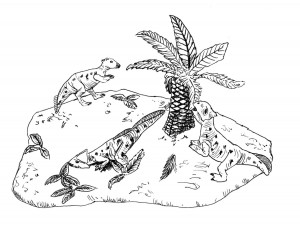New Dinosaur Fossil highlights links between Asian and N. American Dinosaur Faunas
A dinosaur skeleton found nearly a quarter of a century ago has been identified as a new species, linking the evolutionary line of dinosaurs such as Triceratops in North America with ancestral horned dinosaurs in Asia. This new dinosaur named Cerasinops (C. hodgskissi – after the land owner who gave permission for the researchers to excavate), is a primitive member of the Neo-ceratopsia and provides evidence of a link between Asian and North American horned dinosaurs.
Cerasinops weighed about 15 kilogrammes, was primarily bipedal standing just 3 feet tall. It had no distinguishing horns or epoccipitals typical of more advanced Ceratopsidae, but it closely resembles other Neo-ceratopsia recovered from similarly aged rocks in Asia. This indicates that ceratopsians may have evolved either in North America and quickly spread to Asia or vice versa. An alternative theory is that they evolved in the Northern Hemisphere, prior to the substantial break up of Laurasia and spread quickly over land bridges as sea levels changed. This may make the Ceratopsidae a much older group of dinosaurs than previously accepted.
This fossil found 24 years ago near Choteau in Teton County, Montana is going to be put on display for public viewing, at the Montana State University Museum of the Rockies, once preparation has been completed. The specimen has taken so long to prepare as the matrix surrounding it was extremely hard and difficult to remove and the researchers required the assistance of Brenda Chinnery (University of Texas), a specialist in Neo-ceratopsia to confirm that it was indeed a new species.
An Illustration of Cerasinops hodgskissi
Picture credit: Everything Dinosaur
Everything Dinosaur stocks a wide range of horned dinosaur models: Dinosaur and Prehistoric Animal Models and Figures.







Leave A Comment